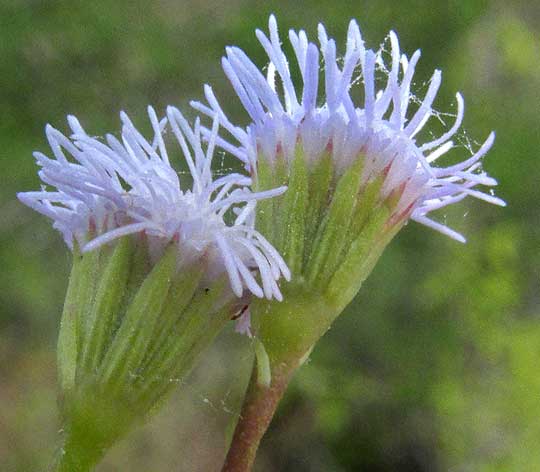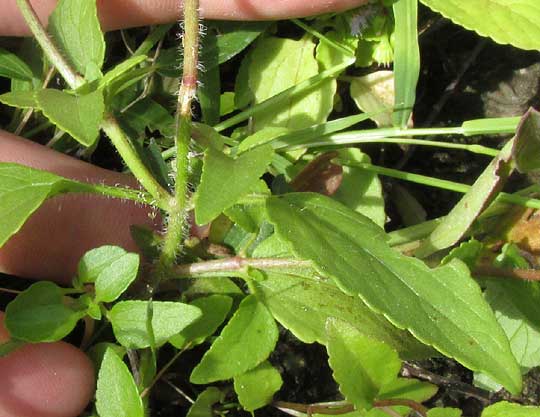Excerpts from Jim Conrad's
Naturalist Newsletter

from the January 25, 2015 Newsletter issued from Río Lagartos, on the Yucatan Peninsula's northern coast (~N21.60°, ~W88.16°), Yucatán state, MÉXICO
GAUMER'S AGERATUM
Probably because last week we received a good rain, several plants are blossoming here in the dry season when I wouldn't expect them to. Where very thin soil spottily gathers atop limestone, this week a wildflower has been prettily and prolifically issuing sprays of small, pale bluish flowering heads, as you can see below in a shot of its typical thin-soiled habitat:

At the top of this page you can see how small the flowering heads are compared to my hand. Even at that distance it's easy to see that this plant is a member of the Composite or Daisy Family, the Asteraceae. Moreover, with its flowers' color and the plant's general form, it looks a bit like the gardener's ageratum of that family. Closer up still, below you can see how each head consists of many cylindrical, closely packed, bluish disk flowers crammed together inside a green, bowl-like "involucre":

The green involucre consists of a distinctive collection of slender, sharp-pointed bracts that are of similar size and arranged in just one overlapping series. Breaking open a flowering head, you can see the blackish, future achene-type fruits at the bottoms of the disk flowers, as shown below:

All these details continue to remind us of garden ageratums, except that the garden plants are larger, with more conspicuous flowers. Even the leaves are ageratum-like, as shown below:

In fact this is indeed an ageratum. In fact, the genus Ageratum consists of 40 to 60 species, most of which are tropical and semitropical plants native to Central America and Mexico, with six species listed for the Yucatan Peninsula.
Our little wildflower specializing in thin soil atop limestone is AGERATUM GAUMERI, occurring from the Yucatan Peninsula south to Nicaragua. The main field mark separating it from other Ageratum species is its smallness. In 2011 we looked at Ageratum maritimum on Mexico's Caribbean coast. That species was not only larger but had semi-succulent leaves. You might enjoy comparing our present Ageratum gaumeri with that one, enjoying "variations on the Ageratum theme," at www.backyardnature.net/yucatan/ageratum.htm.
Traditionally the Maya have used Gaumer's Ageratum, which they call Xta' uulmi, to relieve "rheumatism," and "prickly heat" they believe to result from walking along the trail overhung with dew-wet weeds.